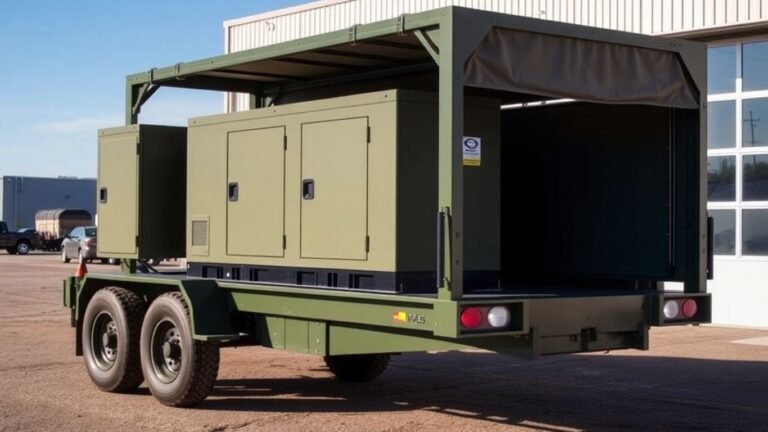Diesel Generator Market Growth: $23.4 Billion Valuation
The global diesel generator market is set to see significant growth in the coming years. A new forecast from MarketsandMarkets™ projects the diesel generator industry will reach $23.4 billion by 2029, up from $17.9 billion in 2024. This marks a steady rise with a compound annual growth rate (CAGR) of 5.4%. The increasing demand for reliable backup power across various sectors is driving this growth, highlighting just how essential the diesel generator has become in today’s energy landscape. It’s a major development for anyone interested in dependable power solutions and energy resilience.
Key Takeaways
- The diesel generator market is expected to grow by $23.4 billion by 2029.
- This growth indicates a 5.4% annual increase from 2024 to 2029, based on the latest forecast.
- A big reason for this market expansion is the increasing need for backup power everywhere.
- North America is likely to be a fast-growing area for diesel generators.
- Asia Pacific is expected to hold the biggest share of the diesel generator market.
Market Size Forecast and Growth Trajectory
Projected Market Value and CAGR Forecast
The diesel generator market is poised for substantial expansion. Projections indicate a market size escalating to $23.4 billion by 2029. This growth is underpinned by a Compound Annual Growth Rate (CAGR) of 5.4%. This forecast reflects increasing reliance on diesel generators across various sectors, driven by the need for reliable power solutions.
Historical Growth and Future Projections
Looking back, the diesel generator market has demonstrated steady growth, fueled by factors like increasing power demand and infrastructure development. Current trends suggest a continuation of this upward trajectory. Future projections account for technological advancements, evolving regulatory landscapes, and shifting end-user preferences. The diesel generator market is dynamic, with historical data informing future expectations.
Key Factors Driving Market Expansion
Several elements contribute to the anticipated market growth:
- Increasing demand for uninterrupted power supply, especially in critical applications.
- Rapid urbanization and industrialization in emerging economies.
- Growing adoption of diesel generators in remote locations and areas with unreliable grid infrastructure.
The need for backup power solutions is becoming more critical than ever. Factors such as extreme weather events and grid instability are driving increased investment in diesel generators to ensure business continuity and safeguard essential services.
These factors collectively create a favorable environment for the diesel generator market to thrive in the coming years.
Key Applications Driving Diesel Generator Demand
Standby Power Solutions Forecast
Standby power is a huge deal for diesel generators, and it’s expected to keep growing. The cost-effectiveness of standby diesel generators makes them a popular choice for homes and businesses needing backup power. These generators aren’t designed for overload, but they kick in when the main power goes out, keeping things running smoothly. Think of hospitals, data centers, and even your neighbor’s house – they all rely on standby generators to avoid disruptions. The reliability of these systems is key, especially in areas prone to outages.
Prime and Continuous Power Requirements
Diesel generators aren’t just for emergencies; they’re also used for prime and continuous power. This is especially true in places where there’s no reliable grid connection. Industries like mining, construction, and even some remote communities depend on diesel generators as their main power source. The demand for continuous power is rising, especially in developing nations where power failures are common. Businesses rely heavily on diesel generators to continue their operations without interruptions. They are mostly used in industries that require a stable power supply, for instance, power, health, and telecommunications. Especially, they are a preferred power source for use in areas which are not connected to the power grid or off-grid such as remote areas, construction sites etc.
Peak Shaving Applications and Growth
Peak shaving is another important application. During times of high electricity demand, power companies sometimes use diesel generators to supplement the grid. This helps avoid blackouts and keeps prices stable. Peak shaving is becoming more popular as cities grow and electricity demand increases. It’s a way to manage the load on the grid and ensure everyone has power when they need it. This is a cost-effective solution for utilities and large industrial consumers. The European diesel genset market is seeing increased adoption of peak shaving strategies.
Diesel generators are vital for ensuring a constant and uninterrupted power supply, which is increasingly important in our digital economy. From running critical medical equipment to supporting remote work, electricity is essential. Diesel generators provide a reliable backup during grid outages, meeting the growing energy demands of modern societies.
Here’s a quick look at the growth in peak shaving applications:
- Increased adoption by utilities
- Growing demand in industrial sectors
- Government incentives for peak shaving technologies
End-User Segments and Their Market Impact

Commercial Sector Demand Forecast
The commercial sector is a big player in the diesel generator market. Think about hospitals, data centers, and office buildings – they all need reliable backup power. The demand here is driven by the need to maintain operations during outages, and that’s not going to change anytime soon. We’re seeing a push for more efficient and cleaner generators, even in this sector. The forecast points to steady growth as businesses expand and require more power security.
Industrial Applications and Usage Trends
Industrial applications are where diesel generators really shine. Factories, construction sites, and mining operations often rely on these generators for prime power. The trends we’re seeing include:
- A move towards more fuel-efficient models to cut down on operational costs.
- Increased adoption of hybrid systems that combine diesel generators with renewable energy sources.
- Stricter emissions regulations are pushing manufacturers to develop cleaner technologies.
The industrial sector’s reliance on diesel generators isn’t going away overnight. The need for continuous and reliable power in these settings is too great. However, there’s a growing awareness of the environmental impact, leading to a search for alternatives and improvements in existing technology.
Residential Market Adoption and Forecast
The residential market is a smaller piece of the pie, but it’s still significant. Homeowners want backup power for emergencies, especially in areas prone to storms or power grid instability. Factors influencing this market include:
- Increasing awareness of the benefits of backup power.
- The availability of smaller, more affordable portable generators.
- Concerns about climate change and extreme weather events.
Here’s a quick look at how different end-user segments are expected to contribute to the diesel generator market:
| End-User Segment | Market Share (Estimated) |
|---|---|
| Commercial | 40% |
| Industrial | 50% |
| Residential | 10% |
As the market evolves, we’ll likely see shifts in these percentages as new technologies and regulations come into play. For example, the adoption of hydrogen generators could significantly alter the landscape, especially in sectors looking to reduce their carbon footprint.
Regional Market Dynamics and Growth Forecast
North America’s Leading Role in the Forecast
North America is expected to show strong growth in the diesel generator market. This is largely due to increasing infrastructure projects and the oil and gas sector’s activities. The demand for reliable power in data centers and the need for backup power in households are also big factors. Plus, diesel generators are often a cost-effective choice for customers in this region. The increasing expansion in manufacturing and construction, particularly in the US, is also expected to boost the diesel generators market in North America.
Asia Pacific’s Dominance in Market Share
Asia Pacific currently holds a significant share of the diesel generator market, and this trend is expected to continue. This is driven by rapid industrialization and urbanization, especially in countries like China and India. The need for continuous power supply in manufacturing plants and commercial buildings fuels the demand. Also, frequent power outages in some areas make diesel generators a necessity for businesses and homes. Here are some key factors:
- Rapid industrial growth
- Increasing urbanization
- Unreliable grid infrastructure
Emerging Markets and Their Growth Potential
Emerging markets in Latin America, the Middle East, and Africa present considerable growth opportunities. These regions often face challenges with grid reliability, making diesel generators a vital source of power. Increased investments in infrastructure development and growing industrial sectors are also contributing to market expansion. The demand for standby power solutions is particularly high in these areas.
The growth in these regions is often tied to specific projects, such as mining operations, construction of new infrastructure, and the expansion of telecommunications networks. Government policies supporting rural electrification also play a role in driving demand for diesel generators in these emerging markets.
Technological Advancements and Design Trends
Stationary Diesel Generator Innovations
Stationary diesel generators are seeing some cool upgrades. It’s not just about bigger engines anymore. Think smarter controls, better fuel efficiency, and reduced emissions. Manufacturers are focusing on integrating digital technologies for remote monitoring and diagnostics. This means you can keep an eye on your generator’s performance from anywhere, which is pretty handy. Also, there’s a push for more compact designs that don’t sacrifice power output. These innovations are making stationary generators more reliable and easier to manage. For example, grid-following converters are becoming more efficient.
Portable Generator Market Evolution
Portable generators have come a long way from those noisy, clunky machines. Now, you’ve got quieter models, some even with inverter technology for cleaner power. The big trend is towards more user-friendly designs. This includes things like electric start, easier-to-read displays, and lighter materials for portability. Plus, there’s a growing demand for dual-fuel generators that can run on gasoline or propane, giving users more flexibility. It’s all about making portable power more convenient and accessible.
Power Rating Segment Analysis and Forecast
Understanding the power rating segments is key to seeing where the market is headed. Different applications need different power levels, and that’s driving innovation in specific areas. For instance, smaller generators are great for residential use and small businesses, while larger ones are needed for industrial applications and data centers. Here’s a quick look at how the segments break down:
- Low Power (up to 50 kW): Ideal for homes, small shops, and backup power.
- Medium Power (50-500 kW): Used in commercial buildings, construction sites, and small industrial facilities.
- High Power (500 kW and above): Essential for hospitals, data centers, and large industrial complexes.
The demand for higher power ratings is expected to grow as urbanization and industrialization continue. This will push manufacturers to develop more efficient and powerful generators. Also, environmental concerns are leading to innovations in emission control technologies across all power rating segments. The bioenergy supply chains are also being optimized for better environmental outcomes.
Market Drivers, Opportunities, and Challenges Forecast
Growing Demand for Uninterrupted Power Supply
The need for a reliable and continuous power supply is a major driver for the diesel generator market. Industries like healthcare, manufacturing, and data centers cannot afford power outages, making diesel generators a critical backup solution. Think about hospitals – a power cut there could literally be life-threatening. This constant demand fuels market growth, especially in regions with unstable grid infrastructure.
Urbanization and Industrialization Opportunities
Rapid urbanization and industrialization, particularly in developing countries, present significant opportunities. As cities expand and industries grow, the demand for power increases exponentially. Diesel generators provide a readily available and relatively affordable solution to meet this demand, both as a primary and backup power source. This trend is expected to continue, driving further market expansion. The diesel generator market share is expected to increase due to this.
Impact of Stringent Government Regulations
Government regulations regarding emissions and noise pollution pose a significant challenge. Stricter environmental standards require manufacturers to invest in cleaner and quieter technologies, increasing production costs. This can impact the competitiveness of diesel generators compared to alternative power sources. However, it also creates opportunities for innovation and the development of more efficient and environmentally friendly diesel generator models.
Navigating these regulations is crucial for market players. Companies that can adapt and offer compliant solutions will have a competitive edge. This includes investing in technologies like advanced exhaust treatment systems and noise reduction measures.
Here’s a quick look at some key regulatory impacts:
- Increased production costs due to advanced technologies.
- Potential shift towards alternative power sources.
- Opportunities for innovation in cleaner diesel technology.
Competitive Landscape and Strategic Initiatives Forecast

Leading Market Players and Their Strategies
The diesel generator market is pretty competitive, with a mix of global giants and smaller regional players all fighting for market share. Key strategies include product innovation, geographic expansion, and forming partnerships to broaden their reach. Companies are investing in R&D to develop more fuel-efficient and environmentally friendly generators. They’re also focusing on providing comprehensive service packages, including maintenance and remote monitoring, to attract and retain customers. It’s a constant game of one-upping each other with better tech and wider service coverage.
Investments and Collaborations Shaping the Market
We’re seeing a lot of activity in terms of investments and collaborations. Companies are teaming up to develop new technologies, expand into new markets, or strengthen their supply chains. Strategic alliances are becoming more common, especially between generator manufacturers and technology providers, to integrate advanced features like smart controls and data analytics into their products. This collaborative approach helps companies share resources, reduce risks, and accelerate innovation. For example, a generator company might partner with a software firm to offer remote monitoring and diagnostics services.
Product Launches and Expansions Forecast
Expect a steady stream of new product launches and expansions in the coming years. Companies are focusing on developing generators that meet evolving customer needs, such as those with lower emissions, higher efficiency, and greater reliability. There’s also a growing emphasis on portable generator options. Expansion strategies often involve targeting emerging markets with high growth potential, like Asia Pacific and Latin America. Product launches will likely highlight advancements in areas like hybrid power systems and alternative fuel capabilities. When considering diesel generator lead times, these expansions and product launches can be affected.
The competitive landscape is dynamic, with companies constantly adapting to changing market conditions and customer demands. Success in this market requires a combination of technological innovation, strategic partnerships, and a strong focus on customer service.
Here’s a quick look at some of the key areas of focus:
- Developing more fuel-efficient models
- Expanding into emerging markets
- Offering comprehensive service packages
- Investing in R&D for advanced technologies
Conclusion
So, what’s the takeaway here? Well, the diesel generator market is clearly on an upward trend, set to hit $23.4 billion by 2029. That’s a pretty solid jump from $17.9 billion in 2024, showing a steady growth of 5.4% each year. It just goes to show that even with all the talk about new energy sources, diesel generators are still super important. They keep things running when the power goes out, which is a big deal for businesses and homes alike. Basically, they’re not going anywhere anytime soon, and their role in keeping our lights on and operations smooth is only getting bigger.
Frequently Asked Questions
How much is the diesel generator market expected to grow by 2029?
The market for diesel generators is expected to grow quite a bit, reaching about $23.4 billion by the year 2029. This means it’s growing at a steady pace of 5.4% each year.
Why are diesel generators so important?
Diesel generators are super important because they give us power when the main electricity goes out. They’re used in places like hospitals, factories, and even homes to make sure everything keeps running smoothly, especially during emergencies.
What’s making the diesel generator market grow?
A big reason is that many places, especially in developing countries, have power outages often. So, businesses and homes need a reliable backup. Also, there’s a growing need for power in general, and diesel generators are a good way to get it.
Which region is seeing the most growth in the diesel generator market?
North America is a key player in this market. They’re building a lot of new things, and there’s more oil and gas work happening, which needs reliable power. Plus, data centers and homes want backup power, and diesel generators are a good, affordable choice.
Who are the main companies making diesel generators?
Some of the big companies making these generators include Caterpillar, Cummins Inc., Generac Power Systems, Rolls-Royce PLC, and Mitsubishi Heavy Industries. They’re all working on new products and making deals to stay competitive.
What’s a major challenge for the diesel generator market?
The biggest challenge is that governments are making stricter rules about pollution and how much fuel generators can use. This means companies have to find ways to make their generators cleaner and more efficient.









One Comment